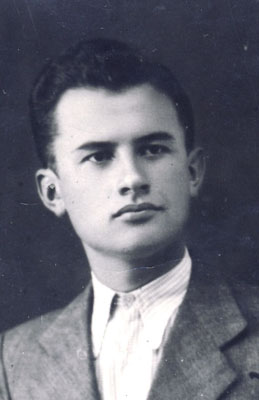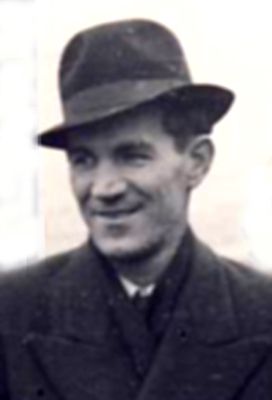| |||||
| Decades: | |||||
|---|---|---|---|---|---|
| See also: | |||||
Events from the year 1954 in Romania. The year was marked by the 1954 Romanian blizzard.
| |||||
| Decades: | |||||
|---|---|---|---|---|---|
| See also: | |||||
Events from the year 1954 in Romania. The year was marked by the 1954 Romanian blizzard.

Chivu Stoica was a leading Romanian Communist politician, who served as 48th Prime Minister of Romania.

Grigore Preoteasa was a Romanian communist activist, journalist and politician, who served as Communist Romania's Minister of Foreign Affairs between October 4, 1955, and the time of his death.

Gheorghe Pintilie was a Soviet and Romanian intelligence agent and political assassin, who served as first head of the Securitate (1948–1958). Born as a subject of the Russian Empire in Tiraspol, he was briefly employed as a manual laborer, and trained as a locksmith, before joining the Red Army cavalry and seeing action in the Russian Civil War. The NKVD shortlisted him for espionage missions in the 1920s, and in 1928 sent him on for such clandestine work in the Kingdom of Romania. Bodnarenko was apprehended there some nine years later, and sentenced to a twenty-years' imprisonment. While at Doftana, he became the ringleader of imprisoned Soviet spies, together with whom he joined the Romanian Communist Party (PCR). He expressed his loyalty toward Gheorghe Gheorghiu-Dej, the jailed communist and emerging factional leader; their tight political camaraderie lasted into the late 1950s.

Carol I Park is a public park in Bucharest, Romania, named after King Carol I of Romania. A French garden located in the southern-central area of Bucharest, partly on Filaret Hill, originally capable of hosting various exhibitions, it suffered considerable modifications during the communist regime, including a name change to Parcul Libertății.

Ion Vincze was a Romanian communist politician and diplomat. An activist of the Romanian Communist Party (PCR), he was married to Constanța Crăciun, herself a prominent member of the party.

Aiud Prison is a prison complex in Aiud, Alba County, located in central Transylvania, Romania. It is infamous for the treatment of its political inmates, especially during World War II under the rule of Ion Antonescu, and later under the Communist regime.

Alexandru Drăghici was a Romanian communist activist and politician. He was Interior Minister in 1952 and from 1957 to 1965, and State Security Minister from 1952 to 1957. In these capacities, he exercised control over the Securitate secret police during a period of active repression against other Communist Party members, anti-communist resistance members and ordinary citizens.

Constantin Doncea was a Romanian communist activist and politician. A railway worker, he played an important part in the Grivița Strike of 1933. Subsequently, imprisoned, he escaped and ended up in Moscow. He then joined the International Brigades during the Spanish Civil War. After spending much of World War II in the Soviet Union, he returned to Romania, where he helped establish a Communist regime. Doncea held a series of posts under the new order, but in 1958 he was removed from the party after clashing with its leader Gheorghe Gheorghiu-Dej. In his later years, he was rehabilitated by the latter's successor, Nicolae Ceaușescu.

Abraham Leib Zissu was a Romanian writer, political essayist, industrialist, and spokesman of the Jewish Romanian community. Of modest social origin and a recipient of Hasidic education, he became a cultural activist, polemicist, and newspaper founder, remembered primarily for his Mântuirea daily. During the 1910s, he involved himself in the effort to unify and reactivate the local Zionist movement. By the end of World War I, Zissu also emerged as a theorist of Religious Zionism, preferring communitarianism and self-segregation to the assimilationist option, while also promoting literary modernism in his activity as novelist, dramatist, and cultural sponsor. He was the inspiration behind the Jewish Party, which competed with the mainstream Union of Romanian Jews (UER) for the Jewish vote. Zissu and UER leader Wilhelm Filderman had a lifelong disputation over religious and practical politics, which gave way to a mutual dislike punctuated by episodes of fraternization.
Events from the year 1944 in Romania. The year was dominated by the Second World War. The year started with the Soviet Army assault on Romanian troops and the Battle of Romania. King Michael led a coup d'état during the year and Romania left the Axis powers and joined the Allies. The Romanian army subsequently won victories against German and Hungarian troops.
Events from the year 1947 in Romania. The year saw the abdication of Michael I of Romania and foundation of the Romanian People's Republic.
Events from the year 1946 in Romania. The year started with the end of the royal strike and ended with the Romanian Communist Party win the first election following the introduction of women's suffrage.
Events from the year 1949 in Romania. The year saw the introduction of collectivization and the first Romanian identity card.

Events from the year 1951 in Romania. The year saw the Bărăgan deportations.
Events from the year 1933 in Romania. The year saw the Grivița strikes, the formation of the Little Entente, and the assassination of the Prime Minister Ion G. Duca.
Events from the year 1964 in Romania. The year saw increasing separation from Soviet influence.
Events from the year 1930 in Romania. The reign of Carol II started during the year, which also saw the foundation of the Iron Guard. The first local election in which women could vote and the only census of Greater Romania were also held during the year.

Dumitru Petrescu, believed to have been born Gheorghe M. Dumitru, also known as Gheorghe Petrescu and Petrescu-Grivița, was a Romanian general, trade union leader, and Communist Party (PCR) activist. After training as a metalworker in Grivița, he took to left-wing politics, joining the underground communist groups at some point before the railwaymen's strike of February 1933, which he helped organise together with Constantin Doncea and Gheorghe Vasilichi. Arrested by the Romanian Kingdom authorities in its wake, he received a 15-year prison sentence. He broke out of Craiova penitentiary a few months later, together with Vasilichi and Doncea, after overpowering a guard. With support from the International Red Aid, Petrescu made his way into Czechoslovakia, and then headed for the Soviet Union, where he lived until 1944. He worked in publishing and trained as a propagandist at the International Lenin School in Moscow.

Jilava Prison is a prison located in Jilava, a village south of Bucharest, Romania.

Văcărești Prison was a prison located in Bucharest, Romania.